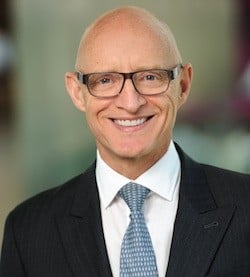Algorithmic trading is a fact of life, and despite the snafus and glitches that make headlines, algorithms have greatly contributed to the efficiency of human traders.
“Everyone recognizes there’s a role for algorithms in trading,” said Stanley Young, CEO of Bloomberg’s enterprise products and solutions. “Algorithms make the process of understanding complex data much easier. They derive their results based on human-driven models, so tasks that would take an hour for a human can be done in seconds or less using algos.”
 Stanley Young, CEO, Bloomberg Enterprise Products and Solutions
Stanley Young, CEO, Bloomberg Enterprise Products and Solutions
The latest headline-making incident occurred this week, when a fake Associated Press tweet briefly sent the U.S. stocks into a free fall, from which they quickly recovered once it was ascertained that the tweet was bogus.
“The marginal benefits from speed over the last five, and yes – even ten years, at best can be measured by a fraction of a penny spread savings in larger capitalization names,” said Sal Arnuk, co-founder of institutional brokerage firm Themis Trading, in a blog posting. These benefits pale “against the costs to the industry from high-speed trading, including increased transaction, technology and data costs, and “a general loss in confidence in our market’s plumbing.”
Although high-frequency trading can increase liquidity, reduce volatility and enhance price discovery and price improvement in global capital markets, HFT firms and venues where HFT is present are failing to safeguard their operations if they do not correctly implement the necessary risk management measures, according to GreySpark Partners, a London-based capital markets consultancy.
“Our research found overwhelmingly in favor of the need for the greater integration of circuit breakers in all high-frequency trading systems that can be used to complement thorough testing procedures for trading algorithms,” said Anna Pajor, a senior consultant in GreySpark’s Capital Markets Intelligence Practice. “We are advocating these risk management steps as examples of necessary risk measures. However, the most successful risk management strategy is the one that assumes a holistic approach.”
By examining HFT risk management through business-centric and technology-centric approaches, trading firms can ensure they are correctly implementing key warning systems and circuit breakers.
“With the increasing fragmentation, electronification and interdependence of markets – as well as complexity of trading systems – the effort to improve risk management can never be considered as completely finished,” said Bradley Wood, a founding partner of GreySpark.” Instead, it is an on-going exercise that requires careful planning and the effective execution of a comprehensive strategy over time.”
The Securities and Exchange Commission’s proposed Regulation SCI (Systems Compliance and Integrity) is designed to ensure that core technology of national securities exchanges, alternative trading systems, clearing agencies, and plan processors meet certain standards, that these entities conduct business continuity testing with their members and participates, and provide certain notification regarding systems disruptions and other types of systems issues.
“The market has to recognize that rogue algos can happen,” said Bloomberg’s Young. “The market, that is, the ecosystem that makes up U.S. trading, has to take steps to ensure they are not susceptible to rogue algos.”
For the past two decades, self-regulatory organizations have followed a voluntary set of principles articulated in the SEC’s Automation Review Policy and participated in what is known as the ARP Inspection Program.
The SEC has noted that the continuing evolution of the securities markets to where they have become almost entirely electronic and highly dependent on sophisticated trading and other technology (including complex regulatory and surveillance has posed challenges for the ARP Inspection Program.














